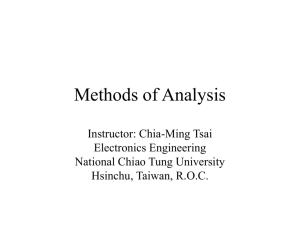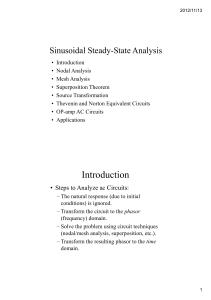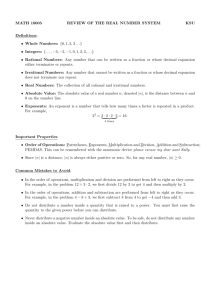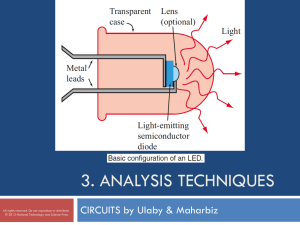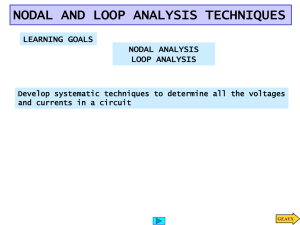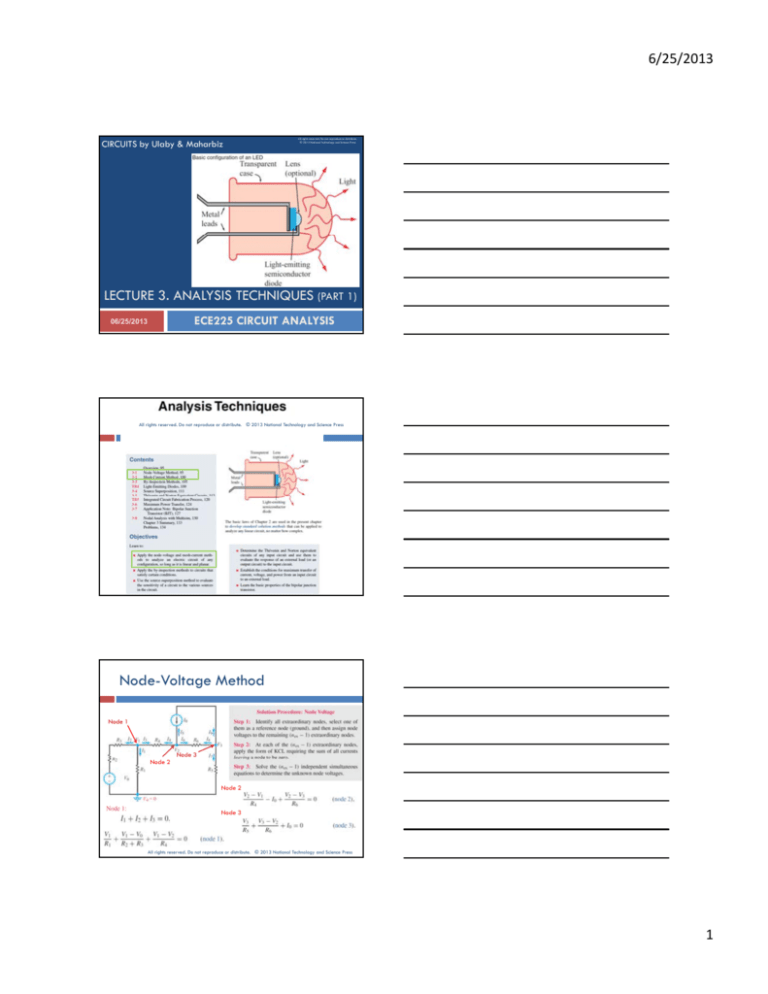
6/25/2013
CIRCUITS by Ulaby & Maharbiz
All rights reserved. Do not reproduce or distribute.
© 2013 National Technology and Science Press
LECTURE 3. ANALYSIS TECHNIQUES (PART 1)
ECE225 CIRCUIT ANALYSIS
06/25/2013
All rights reserved. Do not reproduce or distribute. © 2013 National Technology and Science Press
Node-Voltage Method
Node 1
Node 2
Node 3
Node 2
Node 3
All rights reserved. Do not reproduce or distribute. © 2013 National Technology and Science Press
1
6/25/2013
Node-Voltage Method
Three equations in 3 unknowns:
Solve using Cramer’s rule, matrix
inversion, or MATLAB
All rights reserved. Do not reproduce or distribute. © 2013 National Technology and Science Press
All rights reserved. Do not reproduce
or distribute. © 2013 National
Technology and Science Press
Supernode
A supernode is formed when a voltage source connects two
extraordinary nodes
Current through voltage source is unknown
Less nodes to worry about, less work!
Write KVL equation for supernode
Write KCL equation for closed surface around supernode
All rights reserved. Do not reproduce or distribute. © 2013 National Technology and Science Press
2
6/25/2013
KCL at Supernode
=
Note that “internal” current in supernode cancels,
simplifying KCL expressions
Takes care of unknown current in a voltage source
All rights reserved. Do not reproduce or distribute. © 2013 National Technology and Science Press
Example 3-3: Supernode
Solution:
Supernode
Determine: V1 and V2
All rights reserved. Do not
reproduce or distribute. © 2013
National Technology and Science
Press
All rights reserved. Do not reproduce or distribute. © 2013 National Technology and Science Press
Mesh-Current Method
Two equations in 2 unknowns:
Solve using Cramer’s rule, matrix
inversion, or MATLAB
3
6/25/2013
All rights reserved. Do not reproduce or distribute. © 2013 National Technology and Science Press
Example 3-5: Mesh Analysis
Mesh 1
But
Hence
Mesh 2
Mesh 3
All rights reserved. Do not reproduce or distribute. © 2013 National Technology and Science Press
Supermesh
A supermesh results when two meshes have a current
source( with or w/o a series resistor) in common
Voltage across current source is unknown
Write KVL equation for closed loop that ignores branch with current source
Write KCL equation for branch with current source (auxiliary equation)
All rights reserved. Do not reproduce or distribute. © 2013 National Technology and Science Press
Example 3-6: Supermesh
Mesh 1
Solution gives:
Mesh 2
SuperMesh 3/4
Supermesh Auxiliary Equation
4
6/25/2013
All rights reserved. Do not reproduce or distribute. © 2013 National Technology and Science Press
Nodal versus Mesh
When do you use one vs. the other?
What are the strengths of nodal versus mesh?
Nodal Analysis
Node Voltages (voltage difference between each node
and
d ground
d reference)
f
) are UNKNOWNS
KCL Equations at Each UNKNOWN Node Constrain
Solutions (N KCL equations for N Node Voltages)
Mesh Analysis
“Mesh Currents” Flowing in Each Mesh Loop are
UNKNOWNS
KVL Equations for Each Mesh Loop Constrain Solutions
(M KVL equations for M Mesh Loops)
Count nodes, meshes, look for supernode/supermesh
Summary
All rights reserved. Do not reproduce or distribute. © 2013 National Technology and Science Press
5


